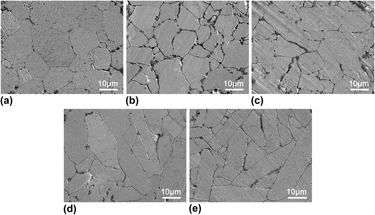Article contents
Synthesis, microstructure evolution, and mechanical properties of (Cr1–xVx)2AlC ceramics by in situ hot-pressing method
Published online by Cambridge University Press: 12 May 2014
Abstract

Nearly dense and almost single-phase bulk (Cr1–xVx)2AlC (x = 0, 0.25, 0.5, 0.75, and 1.0) ceramics were successfully fabricated by in situ hot-pressing method using Cr, V, Al, and C powders as raw materials. A possible synthesis mechanism was proposed to explain the formation of (Cr1–xVx)2AlC solid solutions. The lattice parameters, microstructure, and mechanical properties of the (Cr1–xVx)2AlC ceramics were investigated in detail. The results indicated that the lattice parameters increased with the substitution of Cr by V and the aspect ratio of the grain changed from 1.4 to 3.2. The dependence of the mechanical properties on the V content was a single-peak type. The (Cr0.5V0.5)2AlC ceramic possessed the optimal mechanical performance and its Vickers hardness, flexural strength, and fracture toughness reached the maximum values of 5.18 GPa, 402 MPa, 5.91 MPa m1/2, respectively, due to the solid solution effect. The energy-consuming mechanisms of the material were also discussed.
- Type
- Articles
- Information
- Copyright
- Copyright © Materials Research Society 2014
References
REFERENCES
- 6
- Cited by




